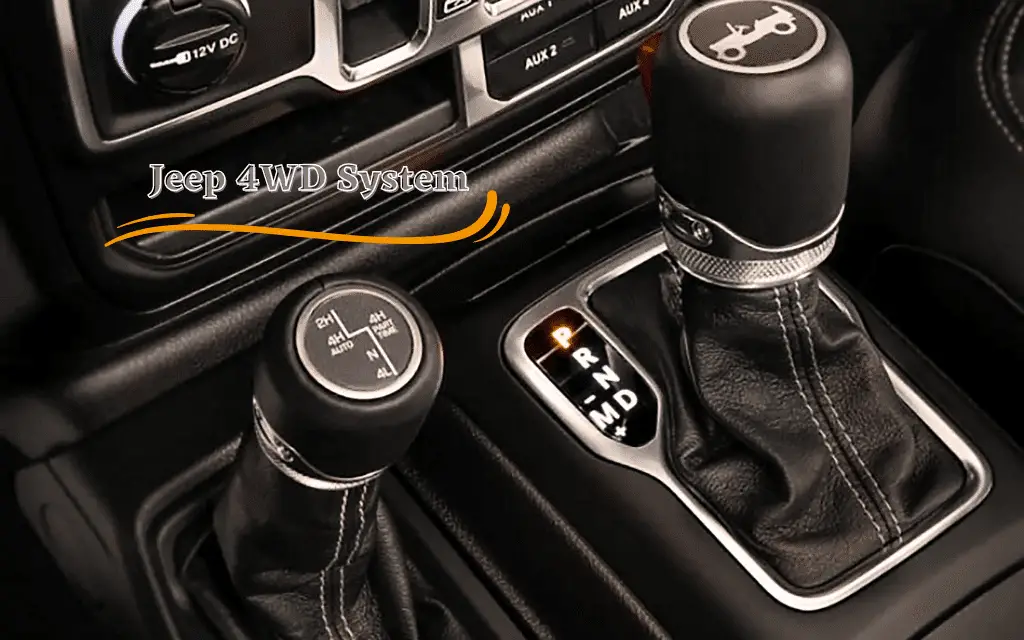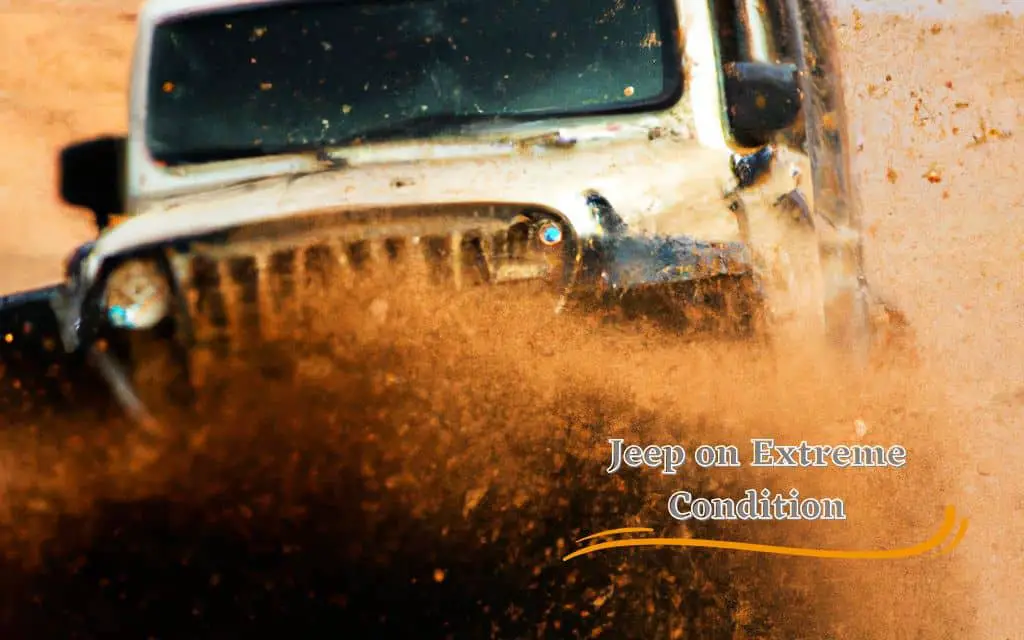Did you know that most Jeep owners don’t know How to Put Jeep in 4-Wheel Drive?
That’s right, even though a Jeep is designed for off-road adventures, many folks are missing out on the full potential of their ride. And it’s because they don’t know how to engage the 4WD system.
But don’t worry. Today, I’m going to show you how to do just that!
In this article, I’ll cover the basics of 4-wheel drive, including what it is, when to use it, and how to engage it on your Jeep.
I’ll also share some tips for staying safe while off-roading and explain the drawbacks of using this system. So buckle up and let’s get ready to hit the trails in your Jeep!
Table of Contents
Overview Of Jeep’s 4 Wheel Drive
If you’re looking for a vehicle that can handle any terrain or weather condition, you should definitely check out Jeep’s 4WD options.
They offer three advanced 4×4 systems – Quadra-Trac 1, Quadra-Trac 2, and QuadraDrive 2 – all with a limited-slip differential.
And if you’re looking for something with even more power, the 2021 Jeep Wrangler Rubicon 392 combines legendary AWD capability with a V8 engine with 470 horsepower.
Inside, the Grand Cherokee offers exceptional materials, craftsmanship, and innovative design for a luxurious experience. And if you’re in the market for a compact crossover SUV, the Jeep Renegade is definitely worth checking out.
Overall, Jeep has been producing reliable and tough 4-wheel drive vehicles since 1986, and they continue to push the boundaries of what’s possible. you can read the 4runner and Grand Cherokee comparison to know more.

Types Of 4 Wheel Drive Systems In Jeep
Before you learn about how to put a Jeep in 4 wheel drive, you should learn about the process lightly. Eventually, learning about the basic types of 4-wheel drive systems will come as a great help in understanding the entire process.
Here are the four different types of 4-wheel drive systems.
1. Part-time 4WD
This is the simplest and most affordable option, which sends power to the rear axles until the driver activates the system manually, usually by pressing a button. This system is best for off-roading situations where extra traction is needed.
2. Full-time 4WD
As the name suggests, this system sends power to all four wheels all the time without the need for driver intervention. This system is great for all-weather driving and provides added grip on slippery roads.
3. Automatic 4-WD
The automatic 4WD system is similar to the full-time system, except that it only activates the 4-wheel drive when necessary. Sensors detect changes in road conditions and send extra power to the wheels in need.
This system is great for drivers who want the benefits of 4WD without having to worry about when to activate it.
4. Selectable 4WD
This system allows the driver to choose when to activate the 4WD system, whether it’s full-time or part-time. This option is ideal for drivers who want more control over their vehicle and need to switch between 2WD and 4WD quickly.
No matter what type of 4WD system you choose, Jeeps are built to handle all kinds of off-roading adventures. With a little bit of research and some test driving, you’ll be able to determine which system is right for you and your next off-road excursion.
How to Find Out If Your Jeep is in 4 Wheel Drive
Sometimes, a Jeep bought new or just second-hand can already be in 4WD. So, before you worry about how to do it, you should check whether it’s already in 4WD or not.
The following tips will help you find it easily.
- If your Jeep has a 4WD indicator light, it’ll usually illuminate when you engage 4WD. Look for a light or symbol on the dashboard that indicates 4WD.
- To verify that your Jeep is in 4-wheel drive, find a safe and flat surface, and engage 4WD according to your Jeep’s manual. Then, try driving slowly and making tight turns. If the Jeep feels resistant or difficult to steer, it’s likely in 4 wheel drive.
- If your Jeep has a manual transmission, check the gear shift pattern. In most Jeeps, the 4WD mode will be engaged by moving the shift lever to a specific position, such as “4H” or “4L.“
- On some older Jeep models, 4WD is engaged by manually locking the front wheel hubs. If your Jeep has locking hubs, make sure they are engaged to use a 4-wheel drive.
How To Put A Jeep In 4 Wheel Drive High?- Step By Step Guide
If you are driving a Jeep and need to put it into a four-wheel drive (4WD), the following steps will help you.
Luckily, the process is not too complicated as long as you follow a few simple steps.
Step 1: Locate the 4WD lever above the center console near the gear shift. If your Jeep has an automatic transmission, you’ll need to shift into neutral before engaging the 4WD. If it’s a manual transmission, push in the clutch while engaging the 4WD lever.
Step 2: Next, you have to turn your Jeep on. For that, just stick your key in the ignition, start the engine, and leave your car in park. Alternatively, I would suggest you drive it under 40 mph for a while.
Step 3: Then, move the lever into the 4H position if you want all-wheel drive. Once you’ve moved the lever, make sure to move the gear selector back to “D” for automatic transmission or shift back into first gear for manual transmission.
You’re now ready to drive in a four-wheel drive! Remember that four-wheel drive is best used for off-road or low-traction conditions.
So use it appropriately and make sure to switch back to a two-wheel drive when you no longer need it.
How To Put A Jeep In 4 Wheel Drive Low?- Step By Step Guide
Ready to gear up your Jeep in 4 Wheel Drive Low? It’s not too complicated! Follow the below instructions sequentially for a smooth process.
- First, come to a complete stop and put the gear shift selector in Neutral while keeping your foot on the brake pedal.
- Then, locate the 4WD lever above the center console near the shift lever and slide it into the 4L position without pausing at N. Great job! Don’t forget to put the automatic transmission back in Drive or release the clutch.
- Now, continue by moving your 4WD shift selector straight down to 4L, and release the brake pedal while at idle speed. Congratulations, you’re in 4-Wheel Drive Low!
- If you’re not sure if you’re in 4 Wheel Drive Low, take a quick test drive to ensure it’s engaged.
Remember, safety is key, so always bring your Jeep to a complete stop before engaging 4WD low. Enjoy your new adventure!
How To Shift From 4 High To 4 Low In A Jeep
Do you need to switch from 4 high to 4 low in your vehicle? It’s easy, and I’ve got a step-by-step guide to help you out.
- First, come to a complete stop and shift the lever into neutral. Then, slightly roll forward (about 3 MPH) while holding down the brake pedal.
- Next, put the 4WD shift selector straight down to 4H. Finally, shift the lever into the 4L position without pausing at neutral.
It’s important to note that trying to shift into 4 low while stopped won’t work. You need to roll forward a bit before making the switch.
And, if your Jeep is automatic, simply shift the lever from 2HI to 4HI while maintaining your speed. If your Wrangler is manual, come to a complete stop and follow the steps we just outlined above.
How To Put Jeep In 4 Wheel Drive In Extreme Conditions
You can also plan to drive your Jeep in extreme conditions while engaging a 4-wheel drive. For that, I would suggest you follow the instructions below sequentially.

- First, make sure your Jeep is in four-wheel drive automatic mode (4A).
- Then, come to a complete stop and shift the lever to the right to engage 4H. It’s recommended to do this while in neutral.
- To disengage the four-wheel-drive system, slow down to a crawl and shift into neutral.
- While still rolling forward, push the lever firmly back to 4H. The low range provides an extreme amount of traction but reduces your speed and burns a lot of fuel. So use it when necessary.
For manual transmission Jeeps, engage 4WD by depressing the clutch and shifting the 4WD gear shifter into 4H while not accelerating.
To shift from 4WD High to 4WD Low, the Wrangler should roll slowly (1-3 mph). With an automatic transmission, shift while stopped. When you’re ready to disengage 4WD, slow down, put the Jeep in neutral, and push the lever back to 4H while still rolling.
Finally, put your Jeep back in gear while pushing the lever from 4H to 2H. Remember, always pay attention to the road conditions and adjust your driving accordingly. Happy exploring!
Which Terrain Setting Should You Choose in Your Jeep?
If you’re driving a Jeep with Selec-Terrain features, then you’ll have the opportunity to choose from a range of terrain settings to optimize your performance based on your current driving conditions.
For example, if you’re driving in snowy or icy conditions, the “Snow” setting will ensure that your vehicle adapts to provide optimal handling and traction.
Meanwhile, “Sand/Mud” is ideal for off-roading, as it allows your Jeep to power through challenging terrain.
However, if you’re not sure what setting to choose, the “Auto” mode will automatically adapt to changing conditions, so you can focus on enjoying the ride.
Ultimately, the choice of terrain setting depends on the environment you’re driving in, so choose wisely and have fun exploring!
Problems While Shifting To 4 Wheel Drive
Shifting to a 4-wheel drive vehicle is definitely a great idea. But if you’re not careful, you might encounter some problems that can make the transition a bit complicated.
To help you out, I’ve compiled a listicle of the most common issues people face when shifting to 4-wheel drive.
1. Faster Wheel Wear
Note that 4-wheel drive comes with faster wheel wear. The pressure on the wheels means they’re going to wear out faster, which can be costly to repair.
If you want to maintain your 4-wheel drive vehicle, you’ll need to replace your wheels more frequently. Keep this in mind when budgeting for maintenance expenses.
2. Switching Between Two and Four-Wheel Drive
Depending on the type of vehicle, you’ll need to switch between two and four-wheel drive modes. This is usually done through a mechanical lever or an electric switch located in the vehicle.
Make sure you understand how to switch between the two modes before you start driving.
3. Automatic 4WD
If your vehicle has an automatic 4WD, it’ll work on two wheels only and convert to 4-wheel drive when it senses the need to do so. This can make driving more convenient, but it also means you won’t have full control over when the mode switches.
4. Torque Vectoring Problem
Front-wheel drive cars can experience the torque vectoring problem under heavy acceleration, but rear-wheel drive cars do not. Keep this in mind when choosing a 4-wheel drive vehicle.
5. Full-Time 4WD
If your vehicle has Full-Time 4WD, you won’t be able to separate the mode and convert it to two-wheel drive. Be sure this is the mode you want before you buy a car with Full-Time 4WD.
6. Part-Time 4WD
Part-Time 4WD allows your vehicle to convert into a two-wheel drive system based on two wheels only, which is suitable for driving on paved streets.
This mode can make driving more enjoyable, but it also means you won’t have access to the benefits of the 4-wheel drive when you need them.
7. Potential Problems with Tires
Remember that 4-wheel drive vehicles may have more potential issues with their tires, especially if you’re buying a used car. Make sure you inspect the tires thoroughly before making your purchase.
8. Excessive Braking Distance
When you put your Jeep in a 4-wheel drive, the system will add stability and balance to the car. At the same time, it’ll extend the braking distance that your Jeep usually needs to come to a complete stop. It can be a big issue, especially for heavier vehicles like a Jeep.
Tips For Using 4 Wheel Drive In Your Jeep
If you are new to using a 4WD, I wonder whether you will like it in the future or not. The fact is you won’t like it unless you manage to use the system properly.
In this case, I can help with some easy-going tips. Make sure to follow the below tips for using a 4WD in your Jeep.
- Don’t use 4WD on Dry Pavements: Your Jeep’s drivetrain design is not intended for high-traction surfaces like dry pavement or highways. Save 4WD for when you really need it, like on wet or icy roads.
- Keep your speed consistent while using 4WD: Traveling faster than is safe for the road conditions can cause your center of gravity to shift, making turning at high speeds extremely dangerous. Keep things steady and safe.
- Avoid sudden turns while using 4WD: Maneuvering or turning on dry pavement can cause your tires to lose traction, resulting in driveline noise, shuddering, or even a bang. Be cautious and avoid sudden movements while using 4WD. You can also care about traction control lite to ensure maximum safety.
- Shift to 4WD in a safe environment: Before using 4WD, make sure you’re in a safe space with enough room to test it out, like a dirt road or off-road trail. And don’t forget to periodically check your vehicle for worn/bad wheel bearings.
Wrapping Up
As we see, putting a Jeep into 4-wheel drive requires stopping the vehicle, engaging the parking brake, shifting the transmission into neutral, and engaging the transfer case into 4-wheel drive.
The specific steps may vary depending on the Jeep model and year. So, it’s important to follow the owner’s manual for detailed instructions.
In this case, make sure to engage 4-wheel drive only on surfaces that provide enough traction to prevent the tires from slipping.
Hopefully, this guide will help you understand the process and do it yourself. But I recommend going to a professional if you don’t have a better idea of the Jeep mechanism. Thank you for your time.
FAQ
How to switch a Jeep into 4-wheel drive?
To switch a Jeep into 4-wheel drive, shift into 4H while driving at low speeds or stop completely to engage 4L for tougher terrain.
Can you put a Jeep into 4WD while driving?
Yes, you can shift a Jeep into 4WD High (4H) while driving at low speeds, but 4WD Low (4L) requires a full stop.
Is Jeep 4x4 always on?
No, not all Jeep 4x4 systems are always on. Some models have full-time 4WD, while others require manual engagement.
